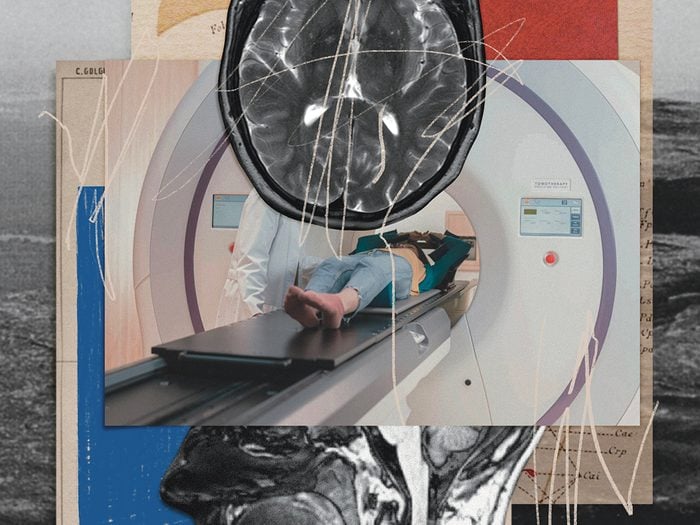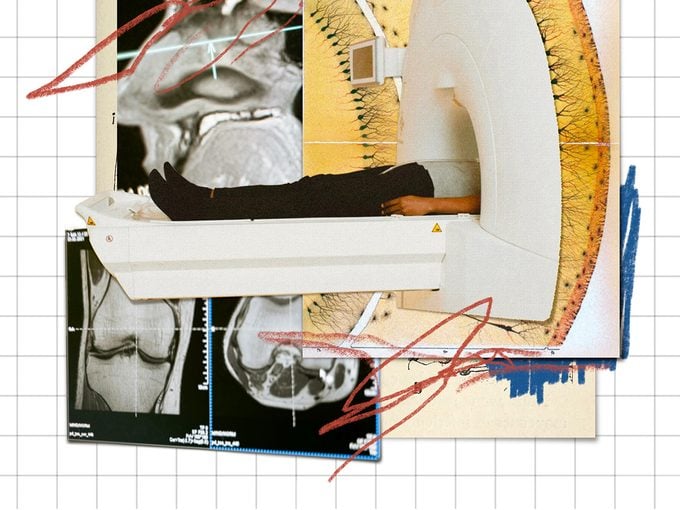Are Whole-Body MRI Scans Too Good to Be True?

They promise to reveal what’s really going on inside your body—for a price. Medical societies and most physicians urge you to save your money.
Milan Frydrysek never worried much about his health. His wife worried enough for both of them. Her brother was diagnosed with pancreatic cancer at age 62 and died a little more than a year later. After that, she wanted to do everything possible to stop cancer from grabbing hold of anybody else she loved.
The Frydryseks heard about Prenuvo, a company that offered diagnostic body scans using magnetic resonance imaging (MRI). For $2,500 per person, they could get a head-to-ankle scan that would pick up solid tumours and 400 other medical conditions, according to the company. Their family physician didn’t love the idea, telling them the scan would likely find things that didn’t matter to their physical health but would make them anxious. The Frydryseks thought the scan might give them peace of mind. In February 2021, they each underwent a one-hour MRI at Prenuvo’s clinic in Vancouver’s South Granville neighbourhood.
Within the week, a 35-page report summarizing the results arrived in their inbox. It broke down the findings by body system and into colours: green meant good, yellow was something to watch and red was urgent. In Milan’s report, under the urinary system section, red letters jumped off the screen. The MRI had picked up a 6.6-by-6.5-centimetre mass on his lower left kidney, “which is suspicious for renal cell carcinoma.”
Frydrysek, who was 69 at the time, contacted his family doctor, who’d also received a copy of the report. The doctor quickly connected him with a urologist. Ten weeks after his scan, Frydrysek underwent surgery to remove his kidney. Pathology confirmed the mass was cancer, but there was no evidence of disease remaining in his body after the operation. “Maybe the tumour was growing my whole life,” he says. “Maybe it would have grown for another 30 years without doing anything. Maybe I would have been gone already. All I can say is, thanks Prenuvo.”
Whole-body MRIs, like those offered by Prenuvo, are now growing in popularity, urged along by a swell of marketing from influencers and celebrities and stories like Milan Frydrysek’s. But this boom in the body-scanning industry is taking place over widespread criticism from many doctors and medical organizations. In the United States, the American College of Radiology issued a statement in April 2023 saying there is no evidence that whole-body screening is beneficial. Health Canada says that “whole-body screening poses a number of health risks and offers no proven health benefits.”
Unlike the targeted MRIs ordered by physicians to investigate a specific health concern, whole-body MRIs are designed to satisfy a person’s curiosity about what’s inside their bodies. There is no physician referral required; just an ability to pay the $2,000 and up fee. These scans pick up lumps and bumps hidden under the skin—things that might be cancer, but might also be entirely innocuous and would never affect a person’s health. The catch: An MRI cannot distinguish with 100 percent confidence whether a finding is harmless or not. A person who receives an unusual finding gets directed back to their regular health team—now, with questions and fears about things that need more investigation in a health system that is already beyond capacity.
Canadians worry that, when something is wrong, they will struggle to access appropriate care quickly in the public health system. More than one in five people in this country do not have access to primary care—that’s six and a half million without a regular doctor or nurse practitioner to turn to when they need help. They face long waits to access potentially life-saving diagnostic imaging. Before the pandemic, Canadians waited an average of 50 to 82 days for CT scans and up to 89 days for MRI imaging, even though the recommendation is 30 days. Against this backdrop, more Canadians are turning to private MRI clinics for medically indicated scans. Private MRIs, first offered in Alberta in 1993, are now available in most Canadians provinces.
Where private whole-body MRIs differ is that they’re sold to people without a clear medical indi-cation—the latest trend in a new era of personal empowerment in health, one where tech sells the promise of optimized wellness through devices like fitness trackers, heart rate monitors and continuous glucose monitoring. In 2010, Rajpaul Attari-wala, a radiologist and biomedical engineer in Vancouver, developed a new MRI machine that could enable privately paid full-body screening. Slowly, his business grew, finding fertile territory in a country where people worried about wait lists for medically necessary MRIs. Now, people were coming to Vancouver from across Canada and even abroad for whole-body imaging.
Eight years after Attariwala started scanning clients with his new MRI, he met Andrew Lacy, an Australian-born, California-based serial entrepreneur. Lacy was looking for his next venture and was interested in investing in the technology. He flew to Canada to undergo an MRI. The scan “told me more about my health than the health system had told me my entire life,” says Lacy. He was sold.
The pair went into partnership. Prenuvo moved its headquarters to California and focused on expanding south of the Canadian border, where markets are bigger and restrictions on private health facilities less complicated to navigate. The technology has improved since its first iterations two decades earlier, with higher image quality and speedier scans. Since then, more companies—including Ezra, Neko Health and simonONE—have joined the whole-body scanning market.
In 2022, Prenuvo opened its first clinic in Los Angeles. With it, the demographics of Prenuvo’s clientele suddenly changed. In Vancouver, the clients had an average age in the early 50s. Now, the clients were younger and into things like biohacking, an obsessive focus on making small changes to diet and lifestyle in order to improve health. Many L.A. clients also came with a sizable media presence. In 2022, American actress and television host Maria Menounos got a Prenuvo scan after months of undiagnosed pain, and it detected a mass on her pancreas, later diagnosed as a stage 2 pancreatic neuroendocrine tumour. In August 2023, Kim Kardashian posted on Instagram that she’d had a scan and wanted to tell her followers “all about this life saving machine.” Her post was not an ad, she wrote.
Lacy says the company did not plan to have an influencer-driven marketing strategy, but welcomed the online recommendations. Whole-body scans are a “completely new category of health care,” he says. “People aren’t googling for preventive health exams. Spreading word of mouth is the most important sort of activity we can do right now.” Prenuvo has offered complimentary scans to certain influencers in exchange for a review. The language used by social media celebrities as they talk about this technology often follows a pattern: They’re getting peace of mind. They’re taking preventative action. They’ll be coming back in future. They usually offer a code in their name for a US$300 discount.
More and more companies in the United States are now selling whole-body MRI scanning, although there are comparatively few in Canada. Prenuvo is the best known among the big players in the indus-try, with eight locations in the United States and another nine in the works. Currently, the company is working on adding a second scanner to its Van-couver clinic, doubling its Canadian capacity, and Prenuvo has plans to expand into Toronto, the U.K. and Australia in the future.
In Ontario, radiologists Nirav Patel and Keyur Shah opened Whole Body MRI in the fall of 2022. They now have locations in Mississauga and Ajax. They offer a 45-minute full-body MRI at $3,250, followed by an optional phone consultation with a radiologist. The pair would not say how many people have signed up for their MRIs, but say that the company is busy without having done much marketing. “We let it speak for itself, honestly. Doctors started coming in first, and then word of mouth. And it’s been growing and growing on its own,” says Patel. The demand is so high that some clinics have wait lists months long. When I checked at Prenuvo’s Vancouver clinic, the next available appointment was more than seven months away.
“I’d rather be safe than sorry,” explains Sarah Astles, 41, who is waiting to undergo her third scan in six years with Prenuvo. Astles used to work as an MRI tech and says she likes to be well-informed about her health; she notes that the scans reduce her anxiety. Her first scan results suggested she had “some kind of a bulge in my lower spine that [Prenuvo] said could be really debilitating.” She says the company encouraged her to return for a follow-up test. When she went back two years later, the bulge was gone. She says she was glad for the information even if the scan was costly and the results ambiguous.
“It was nice to know that, again, if I had major back pain, that’s probably what it was. And I could come back and check it in a year if need be. But if I went to the doctor with that kind of back pain without any other history, I’d probably be waiting a year for an MRI.”
She’s since recommended the screens to her mom and friends. She’d like to send her two children for scans when they’re older. The imaging allows her to feel like she’s not dependent on an overburdened Canadian health system, she says. “I just feel like in Alberta, in Canada in general, you really have to be your own advocate for anything.”

Whole-body MRIs performed on asymptomatic adults tend to pick up large numbers of incidentalomas, the term given to abnormalities detected unexpectedly on an imaging exam. Prenuvo says nearly all of us will have some imaging abnormalities. Some are life-changing, like a cancer diagnosis, and some are subtle things that might not ever make a difference to our health. Others are things to watch. Lacy argues that these findings inspire people to take better care of their health.
Prenuvo and other whole-body imaging companies do not provide the follow-up work to investigate what these abnormalities might be. That task falls primarily to family doctors and other health-care workers. That’s a problem, points out Braden Manns, a kidney doctor and health economist at the University of Calgary. He argues that improvements in modern imaging, along with more imaging being done, have driven up rates of overdiagnoses and incidentalomas. As a result, people are getting further testing, including invasive, potentially harmful procedures like biopsies that could lead to internal bleeding, and treatment for asymptomatic issues that previously would have gone unnoticed and may not have ever required treatment—some gallstones, damaged knees, bulging discs and blood clots, for example.
“It’s actually kind of scary for patients because if you’re well, they’re still going to find two to three abnormalities on the whole-body scans,” he says. “And then, of course, that leads to you going to see your doctor and that causes more stress.” Manns maintains that it’s more valuable for people to get reg-ular recommended evidence-based cancer screening like mammograms and colon cancer checks.
The follow-up investigations after a whole-body MRI also put patients at unnecessary risk for harm, adds David Urbach, a professor of surgery and faculty member of the Institute of Health Policy, Management and Evaluation at the University of Toronto. Whole-body MRIs can lead to more imag-ing, biopsies and surgery—which can cause pain, infection and even death. “In aggregate, [whole-body scanning] will harm your health,” he says.
It also hurts the Canadian healthcare system. Canada’s hospitals and medical clinics are already functioning beyond capacity. So are the people who work in them. The Canadian health system will struggle to manage the increased demand that arises from a growing industry of private-pay whole-body imaging, says Ania Kielar, president of the Canadian Association of Radiologists.
“When people have these types of tests that are done privately, and something is found, they often end up being further investigated within the public health-care system,” she says, “which adds increasing wait times for everybody else, costs to the system, and most of them are found to be benign.”
The current gush on social media for whole-body imaging rarely delves into the downside. It’s easier to convince someone of the potential benefits of screening than to educate them about the limitations, but this information should be presented to potential customers, says John Lysack, a professor of radiology at the University of Calgary. “As the saying goes, a half-truth is a whole lie. To have any chance of making proactive, informed decisions about their health, consumers would also need to understand the potential risks of whole-body MRI,” he says. “In a population of asymptomatic, otherwise-healthy individuals, findings on whole-body MRIs are much more likely to be benign incidentalomas than anything of clinical significance. The catch—and there’s always a catch—is that there’s no way on MRI, or on any other medical test, for that matter, to know with 100-percent confidence that any finding is entirely benign.”
Proponents and critics of whole-body MRI screening agree on one thing: Modern healthcare systems are designed to react to illness, not prevent it. There are limited supports available to help people keep disease at bay.
Lacy, at Prenuvo, says that when people see pictures of their insides, showing them bulging discs or inflammation in the liver, they’ll take preventive action. Manns, the health economist, urges people to do the same thing, but without the accompanying pictures: Take care of your health, he says. Eat properly, get regular recommended screening, exercise, practice good mental health care.
But as anyone who has lost someone to cancer knows, a healthy lifestyle isn’t always protective. For some people, the chance to know that something might be lurking underneath is worth the expense and the risk of potential harms. Milan Frydrysek puts himself in that group.
He hasn’t had an easy time since his diagnosis. After his surgery, he signed up for a medical study that put him on two medications that, it was hoped, would keep him cancer free. He suffered adverse side effects from the drugs, which severely damaged his thyroid and adrenal glands. Then, a regular follow-up scan in the public health system showed his cancer had returned. He now has stage 4 kidney cancer. He’s taking a new medication that has helped reduce the size of his tumours. He hasn’t gone back for a follow-up whole-body MRI; he gets regular scans as part of his cancer care now.
But he’d like his kids to have one. So far, they’ve said no.
Next: Women’s Health Collective Canada Is Addressing the Gap in Women’s Health




